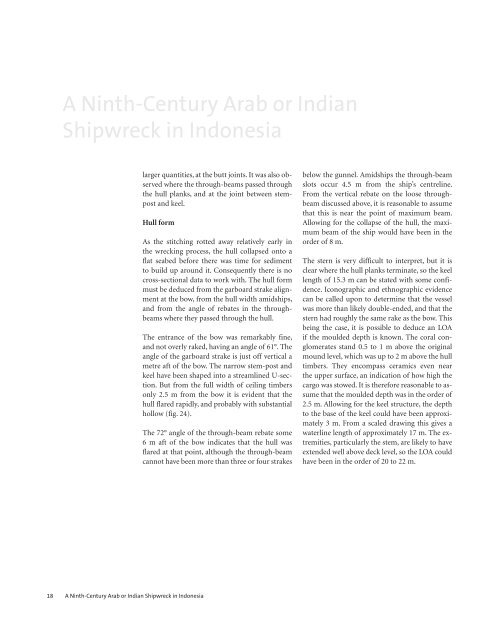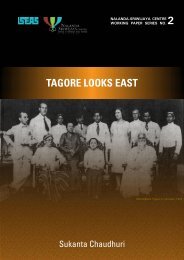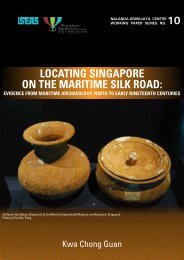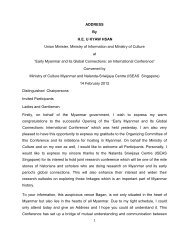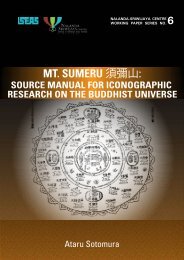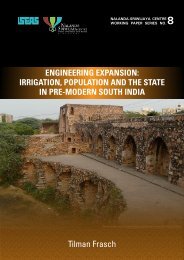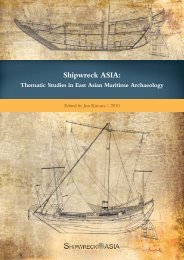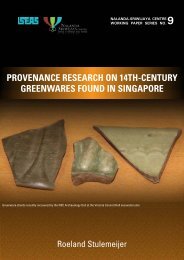You also want an ePaper? Increase the reach of your titles
YUMPU automatically turns print PDFs into web optimized ePapers that Google loves.
A Ninth-Century Arab or Indian<br />
Shipwreck in Indonesia<br />
larger quantities, at the butt joints. It was also observed<br />
where the through-beams passed through<br />
the hull planks, and at the joint between stempost<br />
and keel.<br />
Hull form<br />
As the stitching rotted away relatively early in<br />
the wrecking process, the hull collapsed onto a<br />
flat seabed before there was time for sediment<br />
to build up around it. Consequently there is no<br />
cross-sectional data to work with. The hull form<br />
must be deduced from the garboard strake alignment<br />
at the bow, from the hull width amidships,<br />
and from the angle of rebates in the throughbeams<br />
where they passed through the hull.<br />
The entrance of the bow was remarkably fine,<br />
and not overly raked, having an angle of 61°. The<br />
angle of the garboard strake is just off vertical a<br />
metre aft of the bow. The narrow stem-post and<br />
keel have been shaped into a streamlined U-section.<br />
But from the full width of ceiling timbers<br />
only 2.5 m from the bow it is evident that the<br />
hull flared rapidly, and probably with substantial<br />
hollow (fig. 24).<br />
The 72° angle of the through-beam rebate some<br />
6 m aft of the bow indicates that the hull was<br />
flared at that point, although the through-beam<br />
cannot have been more than three or four strakes<br />
below the gunnel. Amidships the through-beam<br />
slots occur 4.5 m from the ship’s centreline.<br />
From the vertical rebate on the loose throughbeam<br />
discussed above, it is reasonable to assume<br />
that this is near the point of maximum beam.<br />
Al lowing for the collapse of the hull, the maximum<br />
beam of the ship would have been in the<br />
order of 8 m.<br />
The stern is very difficult to interpret, but it is<br />
clear where the hull planks terminate, so the keel<br />
length of 15.3 m can be stated with some confidence.<br />
Iconographic and ethnographic evidence<br />
can be called upon to determine that the vessel<br />
was more than likely double-ended, and that the<br />
stern had roughly the same rake as the bow. This<br />
being the case, it is possible to deduce an LOA<br />
if the moulded depth is known. The coral conglomerates<br />
stand 0.5 to 1 m above the original<br />
mound level, which was up to 2 m above the hull<br />
timbers. They encompass ceramics even near<br />
the upper surface, an indication of how high the<br />
cargo was stowed. It is therefore reasonable to assume<br />
that the moulded depth was in the order of<br />
2.5 m. Allowing for the keel structure, the depth<br />
to the base of the keel could have been approximately<br />
3 m. From a scaled drawing this gives a<br />
waterline length of approximately 17 m. The extremities,<br />
particularly the stem, are likely to have<br />
extended well above deck level, so the LOA could<br />
have been in the order of 20 to 22 m.<br />
18 A Ninth-Century Arab or Indian Shipwreck in Indonesia


